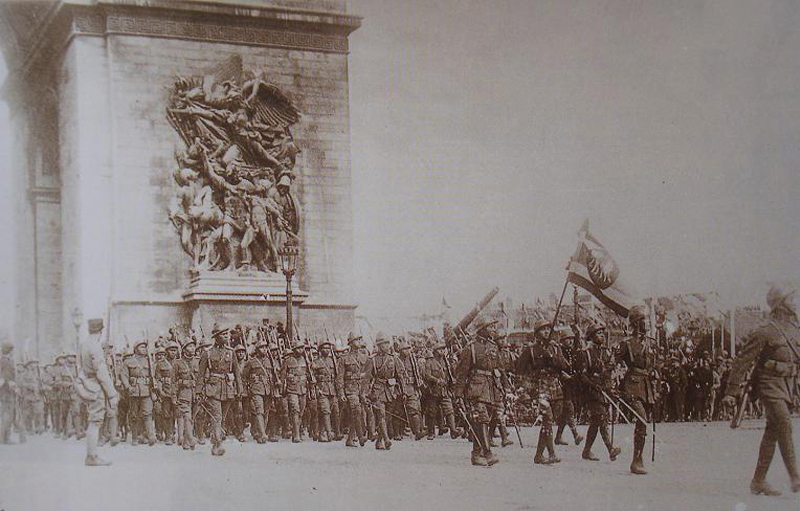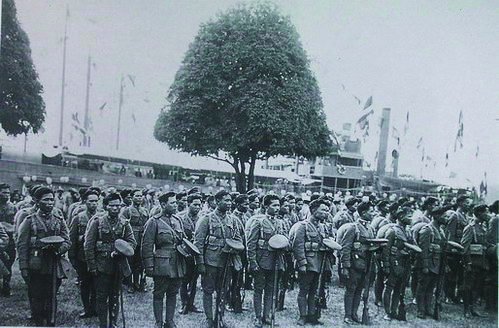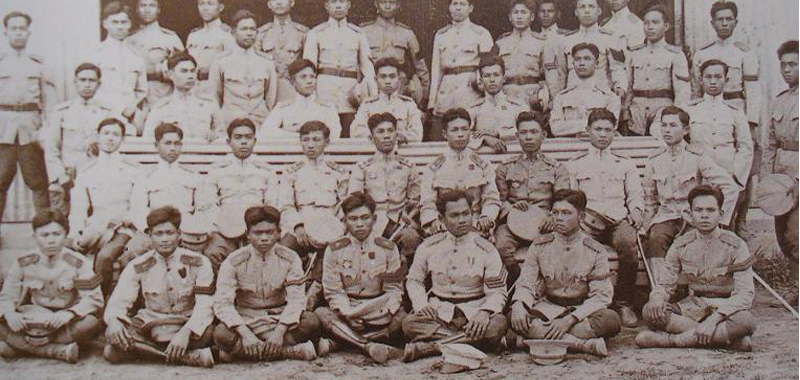
The First World War, which broke out a hundred years ago, led to the downfall of empires and the redrawing of world maps. The horrors of trench warfare and the mechanised slaughter of millions haunt Europe still, as seen in the sombre remembrance services held across the continent last month.
The Great War also played a key role in the development of modern Thailand, though its military role is little more than a footnote in the history of the conflict. Siam, as the country was then known, sent a small force to the Western Front late in the war, winning favour with the victorious allies Britain and France.
The small expeditionary force of 1,284 volunteers – including around 100 pilots – arrived in France in late July 1918, just months before the end of hostilities. The force consisted of an aviation unit, a unit of automobile drivers, and a medical unit. Female nurses volunteered with the medics, reportedly the only women to serve in the trenches on the Western Front. At the end of hostilities, the Siamese troops formed part of the Allied occupying force in western Germany and took part in victory parades in Paris, London and Brussels.
King Vajiravudh (Rama VI) proclaimed that the victory had filled his heart with “the deepest gratification”, and the troops received a hero’s welcome on their return the following year to Bangkok, where they were received by many dignitaries and the Supreme Patriarch sprinkled holy water on them before they marched to the palace. There, the king told them that the country and its people were indebted to them for their service, “which had proclaimed to the world that the Tai race still retained their old fighting blood.”
“The war also had a profound effect on European expatriates in northern Siam”
Nineteen of the troops who joined up died from illness and accidents – two before leaving Siam – though none of them in combat. Today they are commemorated on a memorial in Bangkok’s Sanam Luang, where their ashes are interred. “Since the Siamese Expeditionary Force reached Europe there have been upwards of a dozen casualties, mainly from pneumonia,” Singapore’s Straits Times reported in March 1919. One had died in “an accident with a hand grenade” and another in an automobile accident, it said. Deaths from pneumonia were common at that time as the disease accompanied the global influenza pandemic of 1918-19. The last Siamese veteran of the war, Yod Sangrungruang, died in Phitsanulok in 2003, aged 106.
The decision to go to war on the side of Britain and France – which had both forced Siam to cede territory to their Asian empires – was controversial and divided the royal family, but proved an astute move by Vajiravudh. It spurred the development of a modern military – especially the air force – and for its efforts Siam was given a seat at the Versailles peace talks and the new League of Nations. By the mid-1920s it had renegotiated unfavourable treaties with western powers that gave them some sovereign rights on Siamese territory. Vajiravudh also introduced a new Thai flag, scrapping the old design featuring a white elephant in favour of today’s tricolour. The colours are said to stand for nation, religion and king but red, white and blue are also used in the flags of the Allied powers.
The war also had a profound effect on European expatriates in northern Siam. Germans and Austrians were arrested and interned as enemy aliens, and many Britons left to fight and never came back. Other effects were more mundane.
“The news of the outbreak of the general war in Europe was received in Chiengmai [Chiang Mai] rather late, due to a breakdown in the telegraph line from Bangkok,” Singapore’s Straits Times reported on September 2, 1914. “A few men in Chiengmai tried to corner the market in kerosene, flour, sugar, salt and matches, all due to the war news. Prices went up by leaps and bounds until they reached outrageous heights. Kerosene reached 12 rupees per tin, but purchasers were not to be found. The common people went back to the “lard dips” and then things took a sudden drop.”
One lasting legacy of the war was the boost it gave to aviation, which in Siam – as elsewhere – was then in its infancy. Construction of the Chiang Rai airfield was begun on the orders of the governor, whose brother served as a pilot in France, according to local historians. In a country where road and rail links were at best rudimentary, administrators quickly saw the potential of air travel to boost trade and regional ties.
Another consequence was the delay in the construction of the Khun Tarn Tunnel on the new northern rail line between Lampang and Chiang Mai. German engineers working on the tunnel were rounded up and arrested as enemy aliens when Siam entered the war, meaning it wasn’t completed until 1921.
“Though the organisation of the plans for the placing of the enemy aliens in Bangkok in internment proved an entire success, the authorities did not feel happy till they received news that those at Koon Tan were under arrest and that the tunnel was intact,” the Singapore Free Press and Mercantile Advertiser reported in July 1917, shortly after Siam declared war on the Central Powers.
“Some anxiety was felt about this, as there are said to have been more or less vague threats, and the government was advised that in the case of serious damage a new tunnel would have to be cut. A considerable body of troops was sent north, and there was talk of manoeuvres in Monthon Bayab [Monthon Payap, or Northern State, an old term for Chiang Mai], but in reality they were sent to guard the line. All railways were guarded, and there has been no damage done anywhere.”
Although Siam successfully resisted colonisation, some historians have spoken of Britain’s “informal empire” in the north of the country, where British firms had large interests in teak around Chiang Mai, Lampang, Tak and Nan. It was a strategically important region too, laying between Burma – then administered as a province of British India – and French Indochina. German agents were said to be active in the country, “financing and directing anti-British intrigue among seditious Indians”, according to the Bangkok Times.
“One lasting legacy of the war was the boost it gave to aviation, which in Siam – as elsewhere – was then in its infancy.”
In September 1914, The Straits Times reported that “there are quite a number of British subjects – Burmans, Shans and the like – in northern Siam”, and that “the Germans are actively disseminating their own “news” in that remote region,” with a false telegram purportedly announcing German victories and British losses being circulated. “The British Consulate at Chiengmai had no difficulty in tracing the “telegram” to a German section engineer employed on the railway and have since taken care that the official British news is as widely disseminated as is possible.”
Many of the British ‘teak wallahs’ in northern Siam joined up and were sent to Europe to fight in the trenches. “Ainslie of the Borneo Co. Chiengmai, who joined the Life Guards as a trooper to-day sends a telegram (Sept. 18) that he is off to the front to-morrow: good work after a fortnight’s enlistment,” the Singapore Free Press cheerfully noted in October 1914.
Staff of the big teak firms – the Borneo Company, the Bombay Burma Trading Corporation, Louis T. Leonowens Ltd [founded by the son of Anna Leonowens of the King and I fame] and the Siam Forest Company – all joined up, alongside British policemen, forestry officers, lawyers and bureaucrats working in the country.
“According to latest advices the number of Borneo Company and ex-Borneo Company men now serving with the Colours totals forty-three and includes two directors. One member of the London staff has been killed in action,” The Straits Times reported in August 1915, a year into the war, in a report on the “British-Siam men” who had joined up.
Of the 13 Chiang Mai men who left for the war, only two returned, according to R.W. Wood, the author of De Mortuis: The Story of the Chiang Mai Foreign Cemetery. One of those was Henry Burton Guest Garrett, a London-born botanist and forestry officer who was posted to Chiang Mai in 1902 and stayed until his death, aged 87, in 1959. Several plant specimens today bear his name, and some of his collections were preserved at Kew Gardens in London.
Described as “reserved and parsimonious”, he was known as by his contemporaries as Granny, for his habit of “scratching about like an old hen” – but his modest demeanour belied an impressive war record, for which he was awarded the Military Cross, which is granted for “acts of exemplary gallantry during active operations against the enemy on land.”
“Finding himself on leave in August 1914, he joined up immediately at the age of 43, with a direct commission on the strength of some long ago service in a London Volunteer regiment,” his entry in De Mortuis continues. “He was soon in France, with a mortar detachment, weapons like coal-scuttles, equally dangerous at either end. The range was so short, emplacements had to be sapped out beyond the front line, and hastily abandoned, scuttle, Granny and all, when the German guns had got the range. It was brave work, and no wonder he was awarded the Military Cross. He served out the whole war, somehow without a scratch, and returned to Chiang Mai in 1919 unruffled, as if nothing had happened.”


